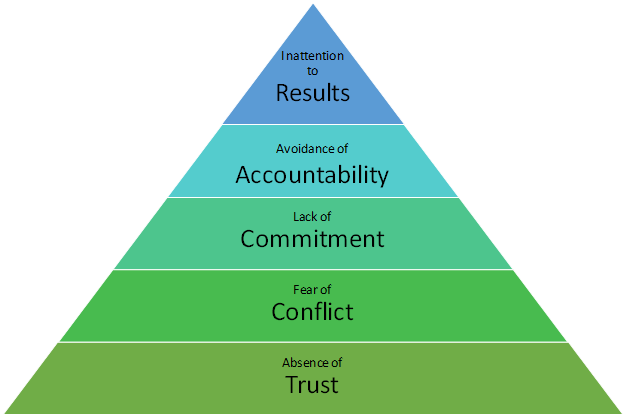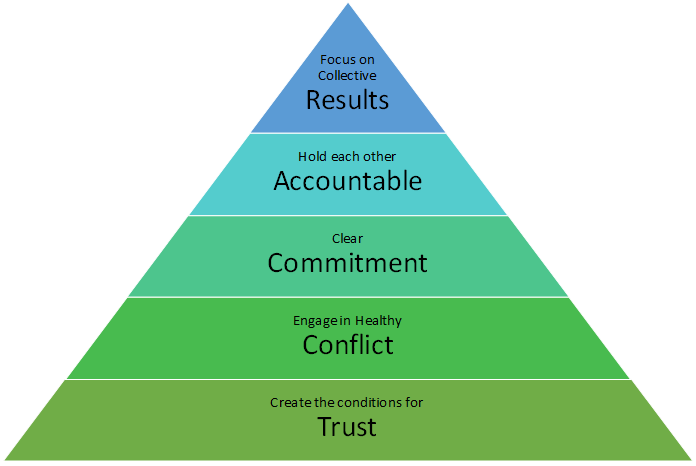This past week, Dennis Corpman and I gave a presentation at IEEE ProCon, a long-standing annual Professional Development conference held by the Cedar Rapids section of the IEEE. Our presentation focused on lessons learned along the agile path. As a way of framing our exploration, we used Patrick Lencioni’s Five Dysfunctions of a Team to examine team interactions in a daily standup, and we used elements of an Agile Mindset to examine a sprint retrospective.
Five Dysfunctions of a Team
I like Five Dysfunctions of a Team. As a model for examining what is happening on a team, I find it easy to remember, easy to explain, and easy to apply. The model is usually expressed in a pyramid diagram; the hierarchy shows how the dysfunctions relate…

- In the absence of Trust – team members won’t be willing to voice their concerns and opinions – healthy conflict is not possible
- Without healthy Conflict – passionate debate about ideas that gives each team member input into decisions – true team commitment is not available; team members may walk away with the appearance of “yes,” but then fail to live up to that “yes”
- In the absence of Clear Commitment – team members are not willing to hold each other accountable
- In the absence of Accountability – team members are more likely to pursue what is personally rewarding, rather than pursuing the collective results of the team
In its “dysfunctions” form, I find the model useful for diagnosis: “Something’s not quite right here, what’s going on?”
Another way of looking at the model is, “What needs to be present for the team to perform well?” Here’s my interpretation:

I find this variation of the model useful in considering team startup and training activities: “What can I help put in place during team startup and training that will help the team know where they are going and how to enable the focus on collective results?” Team startup activities, such as Journey Lines or Market of Skills described in Lyssa Adkins’ book, Coaching Agile Teams, help build the foundation for trust. I also find myself becoming clearer in my Agile Coaching role in setting team expectations about conflict, commitment, and accountability – and modeling healthy versions of these.
It’s just one model
I’ve come to look at models through a lens attributed to George Box. Box, a statistician, is credited with the aphorism (applied to mathematical models): “The most that can be expected from any model is that it can supply a useful approximation to reality: All models are wrong; some models are useful.” I find the same to be true of the conceptual models that we use to describe and analyze Agile teams.
A team model that I was introduced to via Agile Coaching Institute’s Competence Cohort program for Agile Coaches is the Drexler/Sibbet Team Performance Model. The first few stages in this model are:
- Orientation (Why am I here?)
- Trust building (Who are you?)
- Goal Clarification (What are we doing?)
- Commitment (How will we do it?)
While trust shows up in both models, the explicit stages of Orientation and Goal Clarification help provide insights that might be less apparent through the lens of the Five Dysfunctions. Implicit in the “focus on collective results” is that the team is all going somewhere together, and that each team member has a valuable role to play in that journey; looking through the lens of Drexler/Sibbet, these aspects become clearer.
All models are wrong; some models are useful
These are just two models that can be useful in helping an Agile team; there are many other models that have something useful to say. What I find important to remember is that each model helps us focus on certain aspects of the team – while deprioritizing other aspects. In any given situation, a model (or the interventions it suggests) may not turn out to be useful… in which case, it is time to reach into the bag and look at the team through the lens of a different model.
Interested in reading more on this topic? Check out these resources below.
- The Five Dysfunctions of a Team: A Leadership Fable (book)
- Coaching Agile Teams: A Companion for ScrumMasters, Agile Coaches, and Project Managers in Transition (book)
- The 5 “T’s” of Agile Team Startups (blog post)
- Agile Addresses “The Five Dysfunctions of a Team” (blog post)
- Agile Marketing and the Five Dysfunctions of a Team – Absence of Trust (blog post)
- Team Performance Model – by Drexler and Sibbet (blog post)
- Drexler Sibbet Team Performance Model (video)
- The Agile Mind-Set: Making Agile Processes Work (book)
- What Exactly is the Agile Mindset? (blog post)
- What’s Missing In The Agile Manifesto: Mindset (Forbes.com)
- Agile Coaching Institute – Competence Cohort
Originally published April 25th, 2017 on the Innovative Software Engineering blog. Republished with permission.